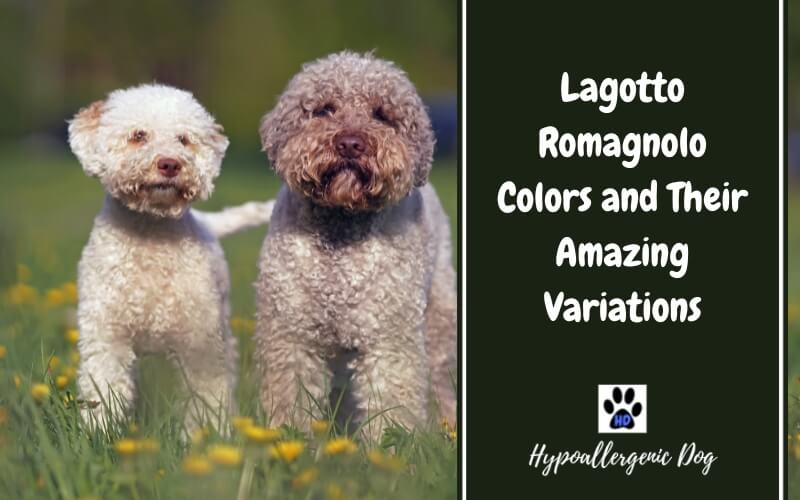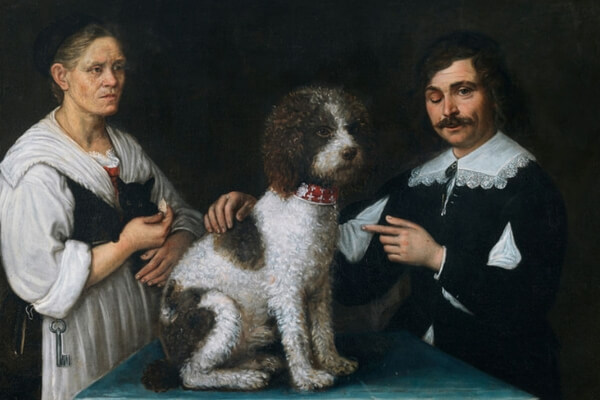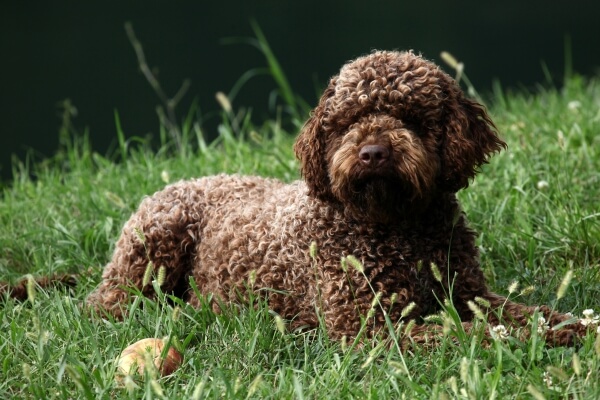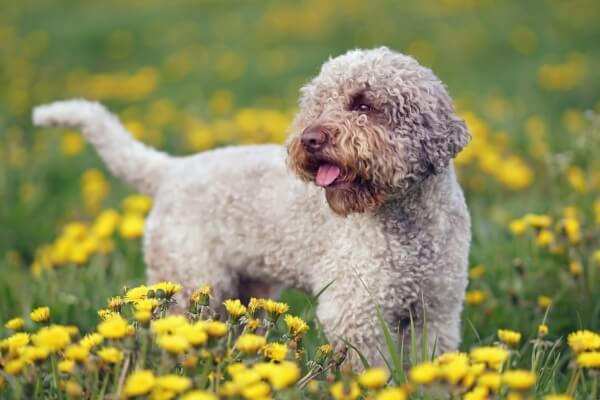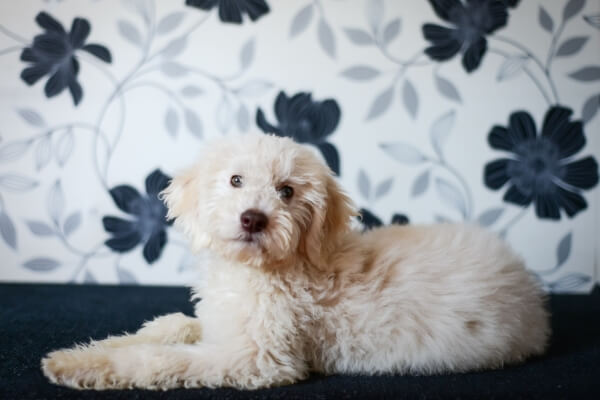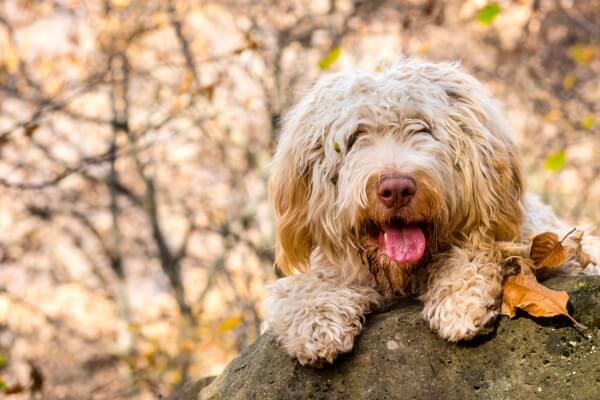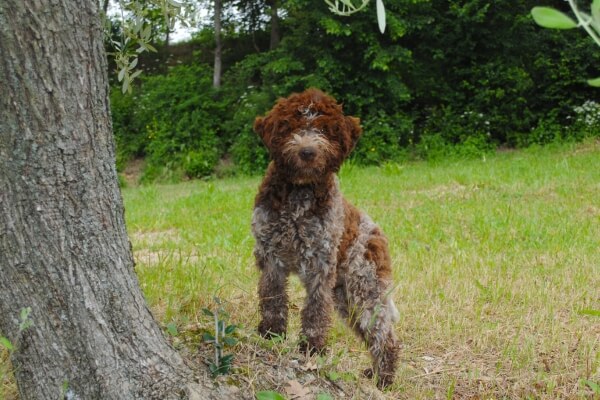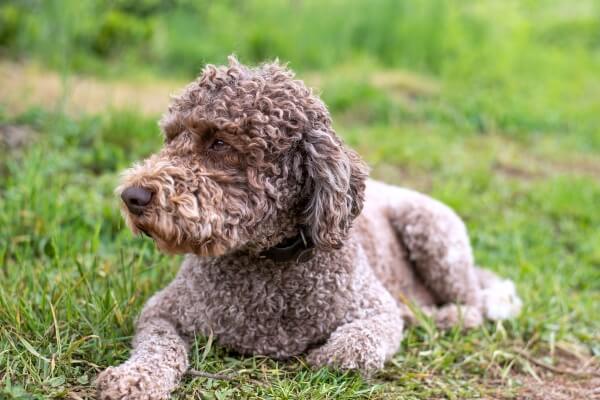The Rainbow Spectrum of Lagotto Romagnolo Colors Revealed
Want to fully understand Lagotto Romagnolo colors? Good luck!
Just like the breed’s history, the Lagotto colors are dramatic, surprising, complicated, and to be frankly honest, mysterious. Their coats can be single-colored or mixed, marked or unmarked, dark shades or light shades — and, to make matters even more complex, typically exhibit completely different colors as adults as they did as puppies.
So, allow me to lead you through the intriguing world of Lagotto coloration — and prepare to have your mind blown!
The Colors of the Lagotto Romagnolo
Ready for this?
A Lagotto can only be one of seven colors. That’s it. According to both the FCI (Fédération Cynologique Internationale) and the AKC (American Kennel Club), these dogs’ curly coats are permitted in the following hues:
- Brown.
- Brown/Roan.
- White.
- Off-white.
- Orange.
- Orange/Roan.
- Sable.
It’s so simple, right? But then, of course, things become a little more complicated. These breed standard colors become subject to an absolute multitude of variants, which, are also permitted, including:
- Brown mask.
- Brown-colored markings.
- Orange-colored markings.
- White-colored markings.
- Tan-colored markings.
- Blends of one color to another.
So, it initially seems that the Lagotto authorities are extremely accommodating — virtually any hue and tone is accepted. Until, that is, you appear at your local dog show with a black Lagotto. Then things can turn nasty.
The Lagotto Color That Dare Not Speak Its Name
Allegedly, Henry Ford once said,
‘A customer can have a car painted any color that he wants, so long as it is black.’
If Mr. Ford was a Lagotto breeder instead of a car magnate, and applied this same coloration rule to his puppies, he would have found himself ostracized, ridiculed, and despised by the kennel clubs. Luckily for him, he made cars and didn’t breed Lagottos (although he did apparently own a German Shepherd, a breed that’s permitted to be black — although it’s rare).
Saying black Lagotto in and around the Romagnolo community is akin to mentioning MacBeth in the theater or saying Voldemort at Hogwarts. You will be made to parade naked through the streets, while the Grand Lagotto Burgermeister rings the Dishonor Bell, with the cries of Shame! Shame! being bellowed by the outraged crowds.
Ok, in truth maybe the treatment won’t be that extreme, but it is a serious issue. You see, Lagottos simply cannot be black. Not should not, cannot.
Purebred Lagottos lack the gene for black coloration, so it’s impossible — and that includes their nose, nails, or any Lagotto Romagnolo black and white combo coat.
Admittedly, you might see some dogs advertised as black Lagottos — and they look very convincing. However, they are not purebreds — they’re a cross, whether by accident or design. Or, they’re just really dark brown.
As a pet, I guess that’s fine. But, if you go to a dog show with a Lagotto showing a solid or patched black coat, a black nose, or any sign of black pigmentation, the dog will be immediately disqualified — as per the AKC regulations.
In addition to the forbidden black, it’s also possible for a Lagotto to be albino. While technically categorized as purebreds, Lagottos displaying albinism aren’t accepted to meet breed standards as they show a genetic disorder.
History of Lagotto Romagnolo Coloration
It’s generally believed that the original Lagotto colors were pure white, white with brown (as above), and white with orange — with the earliest documentation and visual depictions showing this color.
There’s no consensus on how the solid brown and solid orange coats first appeared — although, the majority of Lagotto scholars believe it was due to early crossbreeding with other water dogs. This early doors designer dog fad was undertaken by their handlers, the Lagotti, to create the perfect hunting dog. That said, other mavericks feel it may instead have been a genetic mutation in one breeding dog, which then passed on this DNA to its progeny.
When the breed was brought back from almost certain extinction in the 1970s by the remarkable Quintino Toschi — he bred from the last 32 remaining purebred Lagottos combined with their dog’s closest genetic cousins. This led to today’s Lagottos being over 99 percent purebred — and exhibiting the seven breed standard colors.
Is the Color of a Lagotto Romagnolo Important?
As long as the coat color adheres to the breed standards, the hue, tone, patching, and markings make no difference to the dog. Their temperament, character, intelligence, health (barring albinism), obedience, or trainability aren’t affected by their coloration.
The dog really doesn’t care what shade it is, and so therefore, neither should you.
If aesthetics, fashion, or color coordination are part of your mindset — you probably need to look at your priorities. Lagottos aren’t toys, ornaments, or accessories — nor are they furbabies or snugglepups. They’re proud canines who love to work, swim, hunt, and retrieve. If you want a pretty-colored fluffy puff or whatever you want to call it, get a cat.
Admittedly, some ardent traditionalists may want to hark back to the dog’s original colors of white/white-brown. Additionally, outdoor adventurers may prefer a lighter-toned Lagotto that they can easily spot and monitor as it dives through the undergrowth.
However, don’t go for a darker dog if you think it’s going to mean lower maintenance.
My Lagottos love snuffling, digging, and plowing through bracken and shrubbery. It’s not unusual for them to return from their escapades looking completely filthy — especially my white and white-orange dogs. This propensity for Lagottos to get down and dirty with nature leads many prospective owners to consider a dark-coated dog — as they believe it’s less likely to show the muck.
To be honest, it makes no difference. It will be clean within an hour or so — without you having to bathe or brush the dog.
A Lagotto’s coat will do it on its own, just leave it alone. The dirt dries, the dog shakes, and the muck comes off — due to the protecting nature of the dog’s lanolin-heavy fur. Sure, you might have dust and mud all over your floor — but its coat will be clean.
Description of The Lagotto Romagnolo Colors
Lagotto Romagnolo – Brown
Brown Lagotto puppies are typically born with a seriously dark, almost chocolate color. However, inevitably most of these canines will see their coats lighten as they age.
Experts explain that this lessening of color intensity is due to two factors — an inherent gene within Lagottos that induces fading, and the growth of uncolored hairs that replace the brown. That said, it’s not unknown for the coat to darken and lighten throughout the dog’s life.
Sometimes, a dark brown puppy will grow into a dark brown adult. However, it’s virtually impossible to calculate which dogs will become lighter and which will not — checking
out the canine’s parentage seems to have no relevance. It’s purely in the lap of the dog gods.
Lagotto Romagnolo Colors – Brown Roan
Considered to be the most modern color in the Lagotto breed, the Lagotto Romagnolo roan brown tone tends to exhibit an even mix of white and brown hairs. The way this mix presents itself often means a dog can be incorrectly called a Lagotto Romagnolo grey — despite gray not being a Lagotto color.
Although generally boasting a patched coat when they’re born, the puppies lose this patterning as they age — becoming evenly brown/roan all over. Somewhere in the 8-20 week-old range, small brown spots begin to appear around the larger patches, ears, and nose. The coat then becomes flecked until the dog turns into a brown roan Lagotto.
That said, it’s not just brown-roans that are patched as puppies — so are patched fully-grown dogs! You can often guess how the dog will mature by checking its paws — pink paws usually indicate a patched adult, and brown paws a roan adult.
The Lagotto Romagnolo brown roan is thought to be the most rapid color-changing variety. Literally, in just a few days, flecks emerge and then begin to darken.
Lagotto Romagnolo – White
The inherent Lagotto color change is perhaps most clearly shown in white puppies — you simply don’t know how the dog will appear as an adult.
Admittedly, white adults typically present predominantly white, creamy, or ivory coats as puppies — but so can other colored adults. So, while a white adult most likely was a white puppy, a white puppy doesn’t mean a completely white adult — often turning into an apricot/orange color. And, to make matters even more confusing, white adults can even be orange at birth.
Furthermore, white Lagotto puppies typically display brown or black flecks when they’re newborns. Known as birth markings, these patches and spots will disappear within the first few weeks of the dog’s life — showing that it’s destined to be a white adult.
Many truffle hunters around the world prefer their working Lagottos to be white — as it permits them to be easily spotted and monitored as they explore undergrowth and gorse.
Lagotto Romagnolo Colors – Off White
Factually speaking, the vast majority of white Lagottos are actually off-white.
It’s unusual for a Lagotto to exhibit the gleaming pure white of other breeds — such as the Poodle. That’s why the off-white hue was included in the breed standard, to prevent the majority of the white dogs from being disqualified.
Therefore, in some circles, the white and off-white Lagottos are considered in the same category.
The coat can range from pure white to ivory, and cream to vanilla.
Lagotto Romagnolo – Orange
Often considered to be the most striking of all the Lagotto colors — the orange Lagotto Romagnolo can be a dramatic sight, especially when it exhibits an intense, solid color.
Adult orange Lagottos are virtually always born orange. However, while this may be an incredibly dark color as puppies, in most circumstances the tone fades as they grow up — even becoming a creamy, off-white color. This means that you might choose an orange puppy — only to end up with a white dog!
The consensus of opinion is that the orange color was introduced through early mixed breeding in the 14-16th centuries — and not as a result of genetic mutation.
Lagotto Romagnolo – Orange Roan
Although often referred to incorrectly as the Lagotto Romagnolo orange and white — these dogs are actually orange and roan.
As puppies, they tend to show the same coloration as pure orange adults, yet it’s impossible to tell how they will mature. Furthermore, even if you’re convinced that the young dog will grow into an orange-roan adult, how and where it will be expressed on their coats is a mystery.
They can be roan with just orange ears, front quarter orange and remaining three-quarters roan, or orange-backed with roan bellies. Or, virtually any other combination you can think of. That said, their paws and ears usually show the darkest orange tone.
Lagotto Romagnolo – Sable
Known as zibellino in Italian Lagotto breeding circles, the sable hue is often called tan in Europe and the USA.
In truth, it’s a shade of brown — which is why many clubs outside of the AKC don’t list sable as a breed standard, as it’s automatically included in the brown category.
The Marking Variables
I know what you’re thinking.
When you conjure up the image of a Lagotto in your head, most likely it’s a white dog with some brown patches on its head and back. It’s clearly, therefore, a brown and white Lagotto Romagnolo. In fact, do an online search for Lagottos, and its images of brown and white Lagotto dogs are top of the results.
So, why isn’t Lagotto Romagnolo brown and white included as an accepted standard for the breed colors?
That’s because these dogs are either classed as white or brown — whichever is predominant — although they may have brown or white markings.
The breed standard two-color variations — such as the brown-roan Lagottos — exhibit a generally even mixture of the tones across the coat, or a gradual blend moving from one color to another. Markings describe a clearly defined difference, as if someone has recently come along and painted a splash of new color onto the coat.
Therefore, a Lagotto Romagnolo white and brown-marked dog meets standards, as does a white-marked orange Lagotto Romagnolo. The other acceptable color markings on top of the breed standard coat tones include brown, orange, white, and tan.
How Can You Breed Selective Colors?
You’d think that considering all the Lagotto colors, variations, and markings — breeding tones, patterns, and hues must be complicated, right?
Well, you’re completely correct.
Genetics is seriously perplexing when you have only a few parameters. Throw in a few variables, and the issue becomes exponentially labyrinthine.
Here are the basics — and they’re complex enough.
The color of a Lagotto’s coat — disregarding genetics for a moment — is determined by numerous physical factors. This includes the colors of the hairs themselves, the number of differently colored hairs, how these hairs are distributed across the dog’s body, and the amount of non-colored or white hairs.
Then the genetics come in.
The above variable factors are caused by DNA nucleotides — known as genes. And these genes have their own variants, called alleles. Which, to make matters even more complex, can be dominant or recessive. Two alleles are passed to the future puppy, which inherits one allele from the father and one from the mother.
It’s how these alleles interact that influence how the dog’s coat will look. And Mother Nature, God, Buddha, Vishnu, and luck.
If you’re interested in an in-depth exploration that explains exactly how color genetics work exclusively within Lagotto Romagnolos, check out this article on Lagotto genes.
Lagotto Colors Conclusion
The phenomenal variety and beauty of Lagotto colors and markings are the reasons its popularity is rapidly growing across the world.
However, having no influence on their intelligence, obedience, or temperament — or their ability to give love and companionship — their amazing coats only have a superficial appeal.
As affectionate as it is inquisitive, its background in hunting and truffling and handler loyalty results in a canine that is as happy being an outdoor adventurer as it is a family dog.
So, don’t worry too much about the Lagotto Romagnolo colors, and think more about how their incredible characteristics would make them your ideal companion.

